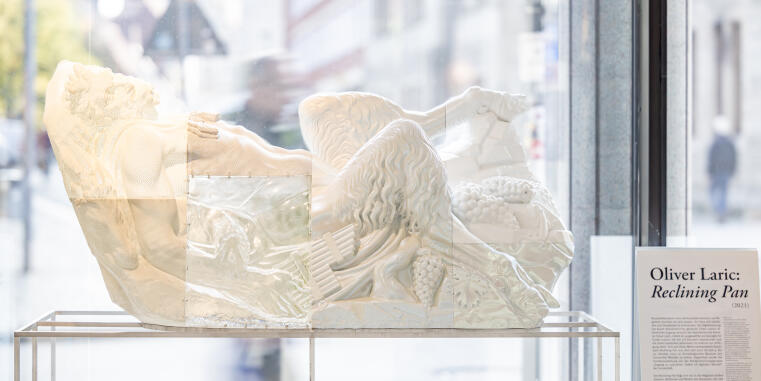

Short video on the „Reclining Pan“
Jon Wiggermann, student of art history and philosophy, explains the special features of Oliver Laric’s “Reclining Pan” – and what questions the artwork raises.

To play the video, it will be loaded from a Webserver of Google™ LLC. Therefore data will be transmitted to Google™ LLC.
Load Video and transmit dataFrom 4 to 30 October 2023, Oliver Laric's sculpture “Reclining Pan” was on display at the Archaeological Museum of the University of Münster. The exhibition was a cooperation between the Centre for Advanced Study and the museum on the occasion of the conference „Zugang gestalten! Hindernisse überwinden“.
You can find the flyer for the exhibition here (PDF download, in German).
Lectures
Two lectures on the special exhibition took place as part of the “Topic of the Month” event series on 22 and 29 October 2023. The two events provided insights into the artistic conception of the sculpture and the curatorial considerations for presenting the work in the context of the archaeological collection. Marei Loreen Klapproth and Jon Wiggermann introduced Oliver Laric’s work and put the methods and potentials of post-digital art up for discussion.
Reclining Pan (2021)
A central theme in Oliver Laric's work is the investigation of the interaction between the analogue and the digital. His artistic practice spans a variety of media, including photographic scanning processes and 3D printing methods. Given the ubiquity of digital reproduction technologies, Laric challenges the notion of uniqueness and authenticity by creating digital duplicates of artworks and historical sculptures from different eras. This leads to a hybrid aesthetic that blurs the boundaries between copy and original.
Laric has been working with digital technologies since 2006. In 2012, an invitation from the museum “The Collection - Art and Archaeology” in Lincolnshire prompted Oliver Laric to develop a concept for a contemporary engagement with the museum’s archaeological collection. Starting with the idea of scanning and digitising, he began measuring selected archaeological finds such as sculptures and reliefs and transferring the 3D data into a digital archive.
He publishes the digital code of the works on a website for free download (threedscans.com), which gives the opportunity to participate in the production, distribution and interpretation of his works. The dimension data recorded in the scan form the basis for the printing process, in which the artist intervenes with different materials or colours, thus making the individual appropriation visible.
The presentation of the Reclining Pan fits in with the casts of ancient statues, portraits and reliefs of the Archaeological Museum of the University of Münster, which have been an indispensable part of archaeological research and teaching since the 19th century. In the context of the casts, which convey an objective representation of the original sculptures in three-dimensional reproduction, Reclining Pan refers to cultural techniques of copying, which already aimed to make the most important works of ancient sculpture accessible at different locations at the same time by means of analogue technologies. Oliver Laric works with 3D scans, which become effective in his works as digital social sculpture. Through the free reusability that forms an integral part of their conception, they unfold their communicative content. While the ready-made declared an already existing industrial object to be a work of art that was lifted onto the museum pedestal, Laric takes the opposite approach: With the 3D scan, the artist takes sculptures that belong to the public domain down from their museum pedestal. He frees them for any form of subsequent use. Thanks to digital technologies, the public domain works are given new artistic interpretations and enriched through public availability. Oliver Laric's sculptures also raise questions in a legal sense, as they undermine the boundaries of work control set by copyright law and create space for ever new transformations, updates and decentralised access. (See Paul Klimpel, “3D Scans and the Law”, in: Mémoire vive. Oliver Laric, exh. Cat., Musée de la Romanité, Nîmes 2023, pp. 99–107).
Oliver Laric
*1981 Innsbruck, lives in Berlin. In his artistic practice, Oliver Laric explores how pictorial works have been (re)used over time and remain available by taking them up and reinterpreting them in original and contemporary ways. 3D models of all his sculptures are available for free download online at threedscans.com.
In 2021, Oliver Laric was awarded the RLB Art Prize, which was accompanied by a solo exhibition at the Ferdinandeum (Innsbruck). Oliver Laric’s works have been shown in solo exhibitions in Amsterdam, Berlin, Ghent, Shanghai, Lisbon, St. Louis, Braunschweig, New York, Winterthur, Savannah, Glasgow, Vienna, Tokyo, Tel Aviv, London and Washington, DC, among others. Works by Oliver Laric are in public collections such as the MuMOK (Vienna), the Philara Collection (Düsseldorf), the Stedelijk Museum (Amsterdam), the Institute of Contemporary Art (Boston), the Cleveland Museum of Art, the Walker Art Center (Minneapolis), the Fondation Galleries Lafayette (Paris) and the KAI 10 | Arthena Foundation (Düsseldorf).
A major solo exhibition at the Musée de la Romanité (Nîmes) is currently showing a commissioned series of sculptures based on scans, produced for the first time in aluminium, entitled Mémoire vive. The exhibition in Nîmes will be on view until 30 December 2023.
Archaeological Museum
The Archaeological Museum of the University of Münster – in existence since 1884 – with its extensive collection offers all those interested exciting insights into the arts and crafts of ancient cultures of the Mediterranean region, the Near East, Ancient Egypt, South Arabia and late medieval and early modern Münster. All the collections – the original collection, the cast collection of ancient sculptures, the model collections of ancient monuments, sites and sanctuaries as well as the coin collection and the hologram collection – are integrated into the teaching and research of the University of Münster, but are also open to the public and schools. In addition, guided tours and lectures on various topics, educational museum activities and exhibitions are offered.

